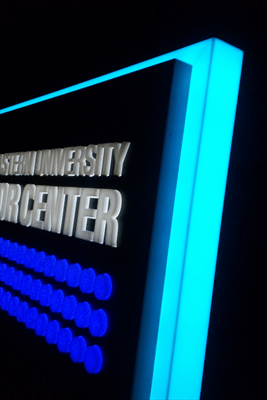The Technology Behind Color-Changing LEDs
Eco-Signage, Exterior Signage, Green, Others, Signage TipsLEDs have become commonplace in our modern society. We see them on our smartphones. They illuminate many different indicators on our appliances and in our cars. Soon, they’ll be illuminating your home and your workplace. They work so well, in fact, that lately we’ve begun retrofitting all types of exterior and interior signage with them.
Aside from their brightness, long life, and power-saving nature, one of the most exciting attributes is their ability to change color.
In point of fact, however, no single LED actually does change color. What the human eye perceives as a color changing LED is actually a group of LEDs housed together, and packaged with a tiny computer that controls their operation.
In the usual configuration, one LED shines red, one shines green, and one shines blue – the three primary colors of light.
When only the red, green, or blue LED is on, you see red, green, or blue, respectively. But when the red and blue are turned on at the same time, you see magenta. The red and green LEDs create a yellow light, while the blue and green gives a kind of pale blue color called cyan. When all three LEDs are shining equally bright, you see white.
By varying the intensity of each LED’s output, which is done by having the computer vary the amount of electricity passing through each of the LEDs, it’s theoretically possible to display almost any color you can imagine.
Decoration and More
Color-changing LEDs are often used purely for decorative effects. For example, some towns now adorn their trees with spheres or other shapes lit internally at night by LEDs which slowly cycle through a rainbow of different colors.
But color changing LEDs have found a more commonplace niche as “status indicators” where there’s too little space for more than one LED, but just causing the single LED to turn “on” or “off” doesn’t cover all the possibilities.
On many smartphones, for example, it’s possible to program a single color-changing LED to display lots of information about incoming calls and the phone’s status.
One additional point: Although a triad of red, green, and blue LEDs are theoretically capable of combining their light to display any color, in fact they are not as good at the yellows as they are at displaying most other colors. To remedy this, some manufacturers are experimenting with adding a fourth LED, a yellow one, in hopes of providing better color fidelity in the range of gold and yellow hues.
Metro Sign and Awning is highly experienced with all types of LED signage. If you’ve got a question, want to show us an LED sign that you like, or have a comment to make, we’d love to hear from you. Call us at 978-401-9270 or contact us online.

